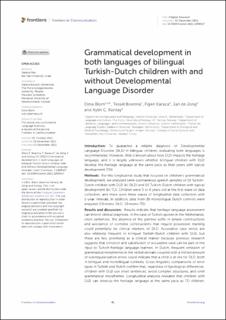| dc.description.abstract | Introduction: To guarantee a reliable diagnosis of Developmental Language Disorder (DLD) in bilingual children, evaluating both languages is recommended. However, little is known about how DLD impacts the heritage language, and it is largely unknown whether bilingual children with DLD develop the heritage language at the same pace as their peers with typical development (TD).
Methods: For this longitudinal study that focused on children's grammatical development, we analyzed semi-spontaneous speech samples of 10 Turkish-Dutch children with DLD (bi-DLD) and 10 Turkish-Dutch children with typical development (bi-TD). Children were 5 or 6 years old at the first wave of data collection, and there were three waves of longitudinal data collection with 1-year intervals. In addition, data from 20 monolingual Dutch controls were analyzed (10 mono-DLD, 10 mono-TD).
Results and discussion: Results indicate that heritage language assessment can inform clinical diagnosis. In the case of Turkish spoken in the Netherlands, short sentences, the absence of the genitive suffix in simple constructions and avoidance of complex constructions that require possessive marking could potentially be clinical markers of DLD. Accusative case errors are also relatively frequent in bilingual Turkish-Dutch children with DLD, but these are less promising as a clinical marker because previous research suggests that omission and substitution of accusative case can be part of the input to Turkish heritage language learners. In Dutch, frequent omission of grammatical morphemes in the verbal domain coupled with a limited amount of overregularization errors could indicate that a child is at risk for DLD, both in bilingual and monolingual contexts. Cross-linguistic comparisons of error types in Turkish and Dutch confirm that, regardless of typological differences, children with DLD use short sentences, avoid complex structures, and omit grammatical morphemes. Longitudinal analyses revealed that children with DLD can develop the heritage language at the same pace as TD children, even if this language is not supported at school. Strong intergenerational transmission and heritage language maintenance among Turkish migrants in the Netherlands may be key. | en_US |

